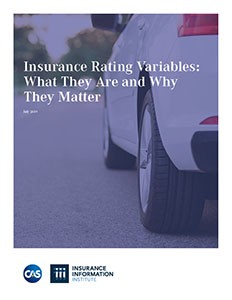CAS and Insurance Information Institute Release White Paper on Rating Variables

Insurance Rating Variables: A Closer Look
New Educational Paper Explains Their Importance, Consequences of Restricting Them
ARLINGTON, VA & NEW YORK – July 24, 2019 – Rating variables are an indispensable tool for setting the cost of insurance and restricting their use can have unintended consequences, according to a new paper released jointly by the Casualty Actuarial Society (CAS) and the Insurance Information Institute (I.I.I.).“Insurance Rating Variables: What they are and why they matter” explains why actuaries apply variables when setting rates – for example using a driver’s age and gender, accident history and vehicle model year to calculate the premium on an auto policy.
“Variables are designed to make insurance affordable and available to everyone,” said Ken Williams, FCAS, CAS staff actuary. “When a variable is removed from rate setting, the consumer stands to lose the most because lower-risk individuals will end up subsidizing higher-risk individuals; or, insurance companies may choose to accept fewer applications from consumers who might cause them to lose money.”
The paper explains that when regulators restrict the use of a particular variable, actuaries may replace it with another variable as a “proxy,” which might not help them price policies as well.
“Imagine that male drivers have higher accident costs and are more likely to drive pickup trucks,” Williams explained. “If gender is restricted, the proxy for gender could become pickup trucks. In this scenario, rates for pickup trucks may increase while rates for other types of vehicles may decrease.”
It is important to note that all rating variables are regulated in every state. That means that proxies cannot directly or indirectly impact groups based on certain characteristics, such as race.
The paper notes that the use of rating variables has resulted in a drastic reduction in the number of consumers seeking coverage in state-supported auto risk pools. Since the increased use of rating variables, the number of consumers in assigned risk pools has decreased almost 90 percent.
James Lynch, FCAS, chief actuary and vice president of research and education at the I.I.I., added, “Rating variables are regulated by state and federal authorities and they meet a variety of important criteria: they are credible, objective, and verifiable. They are an essential tool for setting accurate prices that are lower for low risk customers, higher for high risk customers, yet sufficient to cover an insurer’s costs.”
This is the first joint educational statement the two organizations have developed together. The work is consistent with the missions of both organizations to provide education and ensure that policymakers, the media and the public have sound, objective information on property/casualty insurance issues.
The paper, along with an accompanying infographic, is available from the Casualty Actuarial Society and Insurance Information Institute, and is recommended reading for state and federal lawmakers, regulators and the general public. Williams of the Casualty Actuarial Society and Lynch of Insurance Information Institute are available for media interviews. Contact Michael Barry at michaelb@iii.org or 917-923-8245 to schedule an interview.
About the Casualty Actuarial Society
The Casualty Actuarial Society (CAS) is a leading international organization for credentialing and professional education. Founded in 1914, the CAS is the world’s only actuarial organization focused exclusively on property and casualty risks and serves over 8,500 members worldwide. Professionals educated by the CAS empower business and government to make well-informed strategic, financial and operational decisions. Learn more at casact.org.
About the Insurance Information Institute
Established in 1960, the Insurance Information Institute (I.I.I.) is a nonprofit, communications organization supported by the insurance industry. For more information please visit iii.org.
